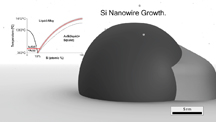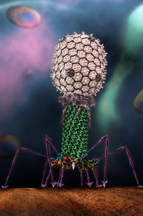
| RELATED INFO |
| * Seyet LLC |
| * Purdue Research Park |
| * Seyet LLC visualization |
November 18, 2008
Animation demystifies complex science; brings nanotechnology to life
WEST LAFAYETTE, Ind. - |
Life science animators from Purdue Research Park-based Seyet LLC recently used their video talents to demonstrate how silicon nanowires form, a process that may change the way computers and consumer electronics are manufactured. Seyet's video provides people who don't have a medical or scientific background a "visual story" of how such complicated organisms or human-designed technologies operate.
"Scientific research is becoming increasingly complex, At the same time, it is important that researchers clearly communicate new discoveries to the public," said Jon Kevan, director of research and design for Seyet LLC, a visual communication company. "The animation of the nanowires demonstrates how a silicon nanowire can 'nucleate,' or begin to form on the way to becoming wires."
Seyet specializes in translating difficult-to-grasp scientific concepts and processes into the highly accurate animated forms now demanded by specialized scientific- and technology-focused audiences, as well as regulatory agencies.
"For example, a National Science Foundation grant is reviewed first on intellectual merit and second on 'broader impacts,'" Kevan said. "Seyet's animations can help fulfill the second criteria for those broader impacts in an innovative way."
 |
A recent video animation was designed for a research discovery by Eric Stach, a Purdue University assistant professor of materials engineering. The video describes his work with an instrument called a transmission electron microscope, which shows how nanowires develop. The research is based at IBM's Thomas J. Watson Research Center in Yorktown Heights, N.Y., and at Purdue's Birck Nanotechnology Center in the university's Discovery Park.
Stach published a paper on his research that appeared in the journal Science this month. It is the first time researchers have made such precise measurements of the nucleation process in nanowires, Stach said.
"This is very complicated science, and showing people how it works is a tremendous help in understanding it," Kevan said. "The demand for new discoveries like Eric Stach's is great, as is the need to explain, in a non-scientific way, their meaning to the public."
Stach's research is funded by the NSF's Electronic Materials Division.
Translating data into visual images, such as showing how nanowires grow, may help researchers secure funding from government and other sources, such as the National Institutes for Health, the U.S. Department of Defense and the U.S. Department of Education.
The company also developed a "Bacteriophage T4" animation for Michael Rossmann, the Hanley Distinguished Professor of Biological Sciences in Purdue's College of Science. Seyet's animation of the virus was downloaded from the Web more than 120,000 times in eight months and was among the most-viewed NSF announcements in 2004.
About Purdue Research Park
The 725-acre Purdue Research Park (https://www.purdueresearchpark.com) has the largest university-affiliated business incubation complex in the country. The park is home to more than 157 companies. About 100 of these firms are technology-related and another 39 are incubator businesses. The park is owned and managed by the Purdue Research Foundation, which received three Excellence in Economic Development Awards from the International Economic Development Council in the categories of Entrepreneurship, Partnerships with Educational Institutions and Technology-Based Economic Development. The park was ranked No. 1 in 2004 for university-affiliated research parks and received the 2005 Outstanding Commercialization Award, both from the Association of University Research Parks. In addition to the Purdue Research Park in West Lafayette, the foundation has established or is currently constructing technology parks in other locations around Indiana including Merrillville, New Albany and Indianapolis.
To the Purdue Research Park, https://www.purdueresearchpark.com
Note to Journalists: Seyet is pronounced "SAY-it."
IMAGE CAPTION:
A frame from a Seyet LLC-generated visualization based on research by Eric Stach, a Purdue associate professor of materials engineering. The image depicts Stach's research of silicon nanowires that demonstrates how a nanowire can "nucleate," or begin to form and become a fully-functioning wire. The process may change the way computers and consumer electronics are manufactured.
A publication-quality image is available at https://www.purdue.edu/uns/images/+2008/nanowire-growth.jpg
IMAGE CAPTION:
A frame from a Seyet LLC-generated visualization based on research by Michael Rossmann, the Hanley Distinguished Professor of Biological Sciences in Purdue's College of Science. The image depicts Rossmann's research on the T4 virus as it penetrates the cell membrane of the E. coli bacterium, which the virus infects
A publication-quality image is available at https://www.purdue.edu/uns/images/+2007/RossmannT4.jpg
Contacts: Cynthia Sequin, (765) 494-4192, (765) 413-6031 (mobile), casequin@prf.org
Emil Venere, (765) 494-4709, venere@purdue.edu
Source: Jon Kevan, (765) 532-0205, kevan@seyet.com